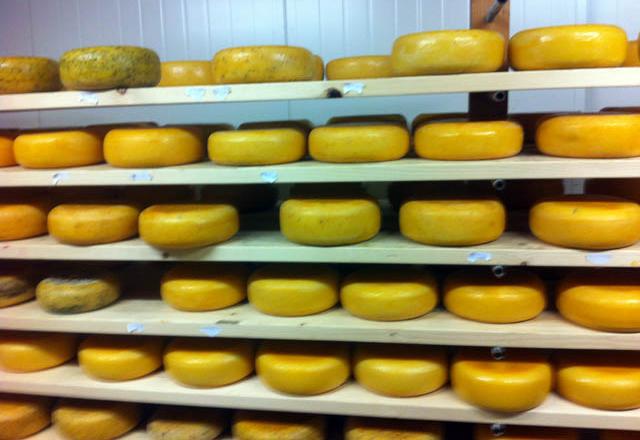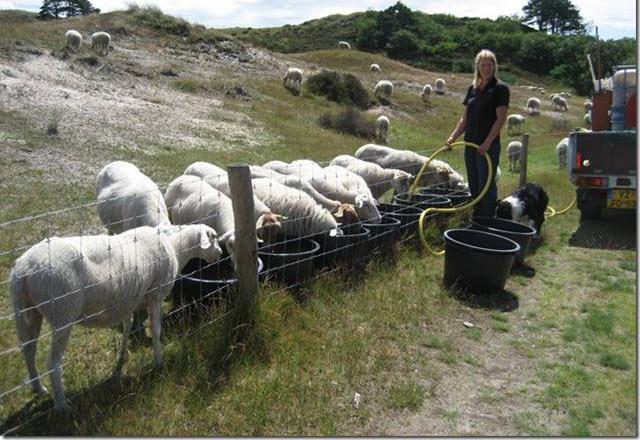You are here
Texel: Family, herd and nature in complete harmony
By Raed Omari - May 25,2014 - Last updated at May 25,2014

TEXEL/THE NETHERLANDS — To dive deeper into the realm of Dutch cheese one must abandon tasting imported cheese and Dutch lamp meat, and instead go to Texel or elsewhere in the Netherlands to gain a better understanding of the Dutch livestock industry and dairy production.
There in the flat green island of Texel, surrounded by the endless vista of the steel grey North Sea, the countryside or in the man-made meadows, sheep farming is more than an industry. It is a cultural heritage preserved in complete harmony with nature.
These impressions emerged during a media tour organised May 11-17 by Holland Branding, a Netherlands Enterprise Agency. The tour included several goat and sheep farms across the country, and to factories, slaughterhouses, laboratories and research centres. Journalists also met with farmers, traders, industrialists and cheese-making housewives.
Owners of the farms, with some dating back to the 19th century, are themselves the shepherds, traders and the professional cheese makers.
In most cases, the farm is a family-run business.
Inside most of the farms visited, there is a modern or traditional factory for producing the Dutch cheese, or what the locals have named “Gouda”, storage for keeping the varied semi-hard cheese and also a small shop where the product is sold.
In Texel, known in the Netherlands and in Europe as the traditional sheep farming island, the stock is nearly as large as the 14,000 humans residing in the area. There are more than 11,000 lambs in the Texel meadows in the springtime, according to Holland Branding.
The island has also named a famous white- faced sheep breed, that has historically been documented as among the most common in the world.
The Texel sheep breed is characterised by broad shoulders, thick neck and short legs with no wool on the head or legs. Texel sheep breeders are spread across the United Kingdom, Denmark, the United States, Brazil, Ireland and Italy, farmers said.
Passing De Waal on the way to Oosterend village on Texel, there is Family Tjepkema, a round 30-year-old family-run farm covering around 89 acres specialising in Texel sheep breeding.
Koos Tjepkeman, owner of the farm with old buildings dating back to the 19th century, said that he has a total of 1,200 sheep, 60 per cent of which are used for meat and the rest for breeding.
“Around 70-80 new-born lambs are sold to other farmers from Great Britain, Belgium and other European countries interested in raising Texel sheep.
“No sheep milk is produced at our farm. The milk is made out of the 320 cows we have,” said Tjepkeman.
He also said that a typical Texel sheep normally gives birth to two lambs that are kept with their mothers for some weeks before being separated.
“Each lamb for breeding purposes is sold at 300 euros and for meat from 100-120 euros.”
“In recent years, we have frequently participated in shows and we have won champion’s titles on many occasions, both with rams we own and with breeding material from our farm,” said Tjepkeman.
In addition to being a cultural heritage passed on by ancestors, Tjepkeman said that sheep farming is a business he performs with pleasure and gratitude despite its arduous nature.
In the Family Bakker farm, there are 300 Texel sheep and 20 Friesland sheep, all used for producing milk and cheese. The farm is located in the Hoge Berg area, a landscape reserve on the Texel Island.
The Texel experience was concluded with a visit to the farm of the Stark family located very close to the island, there sheep and cows graze the man-made wet lands.
The island’s traditional production of Texel cheese, better known as “Texelse Schapenkaas”, has been known throughout Europe for centuries. It is a place that has been recognised as having the finest cheese, and has been called incomparable by many.
In Texel, sheep farming is not a career, instead it is a way of life that defines the people.
Related Articles
In the Netherlands’ northwestern province of Rinnegom, more than 1,000 sheep grazed freely on 750 hectares of a farm; here they were not raised for dairy products but solely for landscape management and nature preservation.
AMMAN — The Ministry of Agriculture has prepared a strategic plan to secure the Kingdom's demand for basic foodstuffs, both plant-based and
AMMAN — The United Nations Development Programme (UNDP) in Jordan has implemented emergency measures to help livestock farmers in "saving th













